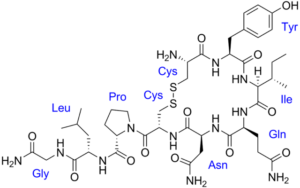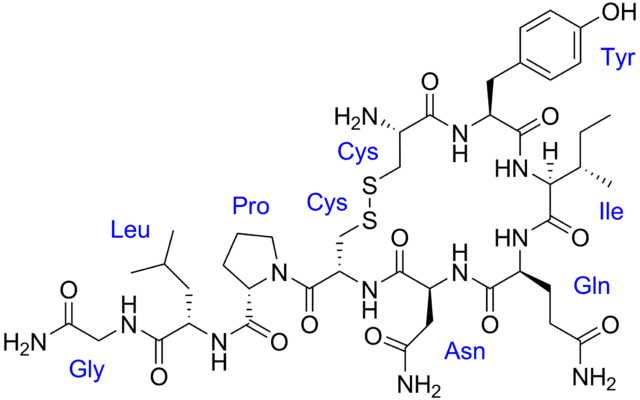Published on November 24, 2014 by Shahram Heshmat, Ph.D. in Science of Choice Oxytocin_with_labelsThe desire to belong arises from the brain reward system. Oxytocin, often referred to as the “trust hormone”, enhances brain reward system (joy and pleasure) in response to love and social bonding and contributes to long-term relationship. Oxytocin exerts a calming effect on the brain, and this appears to facilitate the formation of positive social bond in animals and humans. Perhaps when feelings of insecurity about separation are alleviated, people will simply have more friendly social interactions. Soothing music can also release oxytocin in the brain. The power of music to arouse brain oxytocin was at the center of the 2004 film entitled The Story of Weeping Camel. In the movie about a family of nomad in Mongolia, one camel had just given birth, but with great difficulty. As a consequence, the mother camel showed little interest in her baby and refused to let it nurse. Tradition holds that the playing of violin can sway a camel and reconcile her with her calf. This is exactly what the family did. They brought a musician to the village and played to the mother and baby camels. After a while the mother camel began to weep and gradually moved closer to her baby, in the end allowing it to suckle. Listening to the music and seeing the baby camel nearby, the mother camel associated the sound of the violin with her baby, and under the influence of the music accepted her infant. Evidence shows that if you squirt oxytocin into people’s nostrils they enhance feelings of trust and empathy. This means that it is possible to fall in love with someone just because you had sex with them. With orgasm you get a flood of oxytocin that can cause a feeling of attachment to the person, and you acquire all the characteristics of an addict. You crave the person, and you do crazy things. Oxytocin release also becomes subject to conditioning and various learning experience. For instance, one learns more easily to love people who resemble people one has loved before (similar to drug cues). Among smokers, the release of oxytocin triggered by suckling may contribute to the addictive quality of smoking, as well as to the immediate closeness often shown by smokers. Social bonding can protect against addiction. The presence of strong social bonds in adulthood may decrease the vulnerability to drug abuse. Oxytocin can reduce the pleasure of drugs and feeling of stress. However, for those with impaired oxytocin system, drugs produce a more intense sense of pleasure. Genetics and environment are key factors in the development of oxytocin systems. Adversity (e.g., disturbed bonding or abuse, deprivation) in early life is key to the impaired development of the oxytocin system. In sum, positive social interactions result in the release of oxytocin in the brain, which may be a natural way to reduce addictive behaviors and other psychological problems. For example, in individuals who are already addicted, close relationships between spouses aid in recovery from drug addiction. Similarly, the positive effects of social support groups like 12-step programs have shown to contribute to addiction treatment outcomes.
Oxytocin_with_labelsThe desire to belong arises from the brain reward system. Oxytocin, often referred to as the “trust hormone”, enhances brain reward system (joy and pleasure) in response to love and social bonding and contributes to long-term relationship. Oxytocin exerts a calming effect on the brain, and this appears to facilitate the formation of positive social bond in animals and humans. Perhaps when feelings of insecurity about separation are alleviated, people will simply have more friendly social interactions. Soothing music can also release oxytocin in the brain. The power of music to arouse brain oxytocin was at the center of the 2004 film entitled The Story of Weeping Camel. In the movie about a family of nomad in Mongolia, one camel had just given birth, but with great difficulty. As a consequence, the mother camel showed little interest in her baby and refused to let it nurse. Tradition holds that the playing of violin can sway a camel and reconcile her with her calf. This is exactly what the family did. They brought a musician to the village and played to the mother and baby camels. After a while the mother camel began to weep and gradually moved closer to her baby, in the end allowing it to suckle. Listening to the music and seeing the baby camel nearby, the mother camel associated the sound of the violin with her baby, and under the influence of the music accepted her infant. Evidence shows that if you squirt oxytocin into people’s nostrils they enhance feelings of trust and empathy. This means that it is possible to fall in love with someone just because you had sex with them. With orgasm you get a flood of oxytocin that can cause a feeling of attachment to the person, and you acquire all the characteristics of an addict. You crave the person, and you do crazy things. Oxytocin release also becomes subject to conditioning and various learning experience. For instance, one learns more easily to love people who resemble people one has loved before (similar to drug cues). Among smokers, the release of oxytocin triggered by suckling may contribute to the addictive quality of smoking, as well as to the immediate closeness often shown by smokers. Social bonding can protect against addiction. The presence of strong social bonds in adulthood may decrease the vulnerability to drug abuse. Oxytocin can reduce the pleasure of drugs and feeling of stress. However, for those with impaired oxytocin system, drugs produce a more intense sense of pleasure. Genetics and environment are key factors in the development of oxytocin systems. Adversity (e.g., disturbed bonding or abuse, deprivation) in early life is key to the impaired development of the oxytocin system. In sum, positive social interactions result in the release of oxytocin in the brain, which may be a natural way to reduce addictive behaviors and other psychological problems. For example, in individuals who are already addicted, close relationships between spouses aid in recovery from drug addiction. Similarly, the positive effects of social support groups like 12-step programs have shown to contribute to addiction treatment outcomes.
Social Bonding and Addiction




